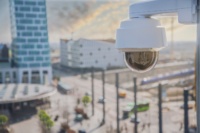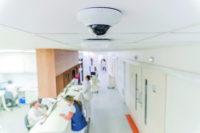Designing a Scalable Video Surveillance Infrastructure for Schools
July 9, 2025

- Define clear surveillance goals early. Schools should identify their specific safety and operational objectives upfront to guide the choice of cameras, video management software (VMS), and integrations. A tailored plan based on a risk assessment helps ensure the system meets real needs rather than adopting a one-size-fits-all approach.
- Standardize and plan for growth. Adopting common camera models and robust network infrastructure across the district simplifies maintenance and future upgrades. School security experts note that standardizing systems yields greater consistency and cost-effectiveness over time.
- Integrate video with broader safety systems. A well-designed surveillance platform doesn’t operate in isolation – it ties into access control, intercoms, and emergency alert systems to support rapid lockdowns and incident response.
Many school districts today find themselves stuck with outdated or piecemeal camera systems that don’t meet current safety needs – and can’t easily scale for future demands. In fact, 97% of U.S. public schools now use security cameras, yet many rely on aging equipment that is cumbersome to maintain. Such legacy or mismatched systems often leave coverage gaps and cybersecurity vulnerabilities, turning what should be safety assets into liabilities. The challenge might be a lack of system integration, grainy video quality, or limited centralized control; any of these issues can undermine an otherwise well-intentioned security effort.
If you’re planning an upgrade, it’s time to think beyond individual devices. Industry best practices emphasize a layered, standards-based approach over ad-hoc fixes. Schools benefit most from open-platform solutions that adhere to industry standards, eliminating the constraints of proprietary systems. Here’s what you should consider before investing in your next video surveillance infrastructure.
Define System Objectives Before You Specify Hardware
Effective infrastructure design begins with clarity around use cases. Are you primarily supporting real-time incident response, post-event investigations, lockdown coordination – or a combination of all three? Identifying these goals upfront informs decisions on camera types, coverage areas, retention policies, and integration requirements. In practice, a district focused on forensic review of incidents might deploy more multi-sensor IP cameras with panoramic views and high zoom for detailed playback. A district prioritizing real-time response will look for cameras and VMS analytics that can trigger immediate alerts and share live video to security staff or police. These are not one-size-fits-all choices – every and each use case demands different specifications and configurations.
Leading school safety frameworks echo this emphasis on planning. The Partner Alliance for Safer Schools (PASS) guidelines, for example, encourage administrators to first ask “What should we do?” – identify specific threats and needs through assessment – and then “How do we do it?” by selecting the appropriate technologies and procedures. Taking this strategic approach helps ensure your surveillance system is purpose-built. For example, if one goal is incident reconstruction after a fight or vandalism, you might need cameras with ultra-high resolution and wide coverage to capture critical details. If another goal is active monitoring for emergencies, you’ll need AI-enabled cameras or software that can recognize weapons or unsafe behaviors and notify responders in real time.
Prioritize VMS Compatibility and Multi-Site Control
The Video Management System is the operational hub for surveillance across your district. A robust VMS platform enables school administrators and IT departments to manage hundreds or even thousands of camera feeds with relative ease. Systems like Milestone XProtect or Genetec Security Center provide , allowing authorized staff to monitor live feeds in real time, review and tag recordings, and administer user permissions from one unified interface. Crucially, these enterprise-class VMS solutions are designed to handle multi-site deployments, a critical feature for districts managing dozens of campuses.
Compatibility is key when selecting a VMS. Insist on open-architecture, standards-based software that plays well with others. For example, an ONVIF-compliant VMS can integrate with IP cameras from most major manufacturers, ensuring you’re not locked into a single brand for future expansions. Open standards like ONVIF (a widely adopted interoperability standard) allow cameras and recording systems across different brands to work together seamlessly. Your VMS should also have APIs or built-in integrations for third-party systems; access control panels, gunshot detectors, visitor management systems, and mass notification platforms. The ability to tie video events to door alarms, intercom calls, or panic button triggers is invaluable in an emergency. In short, the VMS should be the nerve center of your security ecosystem, not an island.
When evaluating VMS options, consider how they handle scalability. Can the system support the number of cameras you plan today and easily add more tomorrow? Look for features like hierarchical or federated management, which let you link multiple school sites into one system. For instance, a district might centrally manage all video through a core VMS while each campus has local recording servers for redundancy. The best platforms support this with ease – they let you view any camera district-wide from HQ but also allow local campus authorities to access their own cameras with appropriate permissions. In advanced implementations, some districts even establish a full Security Operations Center (SOC) to monitor all schools, a concept reflected in Tier 4 which envisions a 24/7 security center with feeds from every campus. Even if you’re not building an SOC today, choosing a VMS that could feed one in the future is wise.
Standardize Devices to Simplify Support and Scaling
Device fragmentation is a common issue in legacy school surveillance systems. Mixing too many camera brands, models, and firmware versions across campuses leads to inconsistent video quality, complicated maintenance, and steep learning curves for staff. One school might have aging analog DVRs while another has newer IP cameras, a recipe for headaches when something goes wrong. To break this cycle, aim to standardize your surveillance hardware and configurations as much as possible. By using a set of approved camera types (for example, a standard dome for classrooms, a standard bullet camera for exteriors), you streamline everything from installation to user training. Technicians can keep attic stock that cover all schools, and IT staff only need to learn one interface for configuration. Over time, this yields major efficiency gains and cost predictability in support.
Think About Credentialing and Access Control

Your video surveillance system becomes far more powerful when it’s integrated with your access control and credentialing systems. Simply put, the moment someone swipes a badge or punches a code at a school door, a well-integrated system should automatically call up the corresponding camera feed. If an registers a door forced open or an attempt at an odd hour or a door is left ajar, it should trigger an alert and cue nearby cameras to display or record at higher frame rate. Designing these linkages in from the start greatly enhances situational awareness. The system moves from passively recording to actively monitoring access events in real time. Schools that plan video and access control together can create workflows where, for example, a door held open too long sends an immediate notification with video clip to administrators’ phones, or a main entrance intercom call allows the front desk to both talk to the visitor and visually verify them via camera before buzzing in. When schools account for these connections early, everything works smoother. It saves the time and cost of retrofitting integrations later on. A good practice is to insist that your access control platform and VMS are either natively integrated or have reliable middleware tying them together.
Beyond software integration, consider the credential technology itself. Many K–12 schools are upgrading from older swipe or proximity cards to more secure, encrypted smart cards or mobile credentials. Standards-based communication (such as the Security Industry Association’s OSDP protocol for reader-to-controller communication) provides encrypted, two-way authentication that is far more tamper-resistant than legacy Wiegand badge readers. By choosing secure, modern card reader technology and linking it with video verification, you significantly harden your front line of defense. A well-integrated system ultimately lets administrators monitor and respond to movement across campus without constantly switching contexts
Build for Lockdown Scenarios
In K–12 environments, surveillance systems must play a direct role in emergency protocols, particularly lockdown and lockout procedures for threats on or near campus. A truly scalable system should interface with one-button lockdown solutions, electronic door hardware, and public address (PA) systems to coordinate immediate responses. This means thinking in advance about how your cameras and VMS will behave during a crisis. In practice, you might design the system so that a press of a wireless panic button by a staff member simultaneously locks all exterior doors, triggers an automated PA announcement, and brings up all key camera feeds in the security operations center or on administrators’ screens. Such automation can save precious seconds.
Video surveillance provides critical situational awareness during a lockdown. The PASS guidelines specifically recommend incorporating live video into emergency response plans so that those managing the incident can see what’s happening in hallways, entrances, and other hotspots. Live feeds can also be shared with law enforcement responders en route to the school. For example, under the standard for active shooter response, first responders establish “hot,” “warm,” and “cold” zones to designate threat levels in different areas of a building. Real-time information from the school’s cameras can help police determine which zones are safe for EMS personnel to enter. In the stress of an unfolding emergency, having eyes on the ground through your surveillance system is invaluable for informed decision-making.
Plan for Ongoing Management and Evolution
Installing a surveillance system is not a one-time event, it marks the start of an operational lifecycle that includes regular updates, testing, training, and expansions. To keep your infrastructure effective over the long haul, districts should adopt a proactive management plan. This plan might include scheduled system health checks (to verify all cameras are online and recording properly), periodic firmware and software updates (to patch security vulnerabilities and add new features), and annual training refreshers for the staff who use the system. In fact, PASS experts recommend that critical security components like access control, video surveillance, and alarm systems be often during summer breaks, to catch any malfunctions and ensure everything is functioning as expected.
Part of evolution planning is also budgeting for eventual expansions or replacements. Camera systems have finite lifespans, generally 5-10 years for hardware, and your coverage needs may grow if you add new buildings or face new threats. Administrators like to say that adding analytics (such as weapon detection AI) isn’t just a software tweak; it often requires verifying that your current cameras and networks can support it. These are the kinds of forward-looking questions a good management plan will continually ask. By treating your video surveillance setup as a living program, one that adapts, improves, and is well-maintained, you avoid the fate of “install and forget” that leaves many systems ineffective when they’re needed most.
Avoid Short-Term Thinking
In tight budget environments, it’s easy to gravitate toward the cheapest or quickest fix for a security need. Many districts have made the mistake of purchasing based on short-term convenience, for example, adding a few off-the-shelf cameras to cover a blind spot, or choosing a closed proprietary system donated by a vendor, only to regret it a few years later. The result of ad-hoc decisions is usually a patchwork of incompatible equipment and outdated software that becomes costly to maintain (or impossible to expand without starting over). To build a truly scalable infrastructure, it’s critical to think long-term and holistically. This means favoring standards-based components and forward-compatible systems, even if they carry a higher upfront price. Open-platform hardware and software allow your district to grow and adapt without ripping out and replacing core systems every time needs change. In contrast, a bargain system that can’t integrate with others or isn’t built on open standards might essentially be a dead-end technology, it meets today’s need but blocks tomorrow’s progress.
Fortunately, the industry trend is toward interoperability and unification. When specifying your next video surveillance purchase, consider how it will fit into the larger ecosystem we’ve discussed: Can it feed into your central VMS? Does it support open protocols for integration? Will it accept firmware updates to enable future analytics? A good litmus test is whether the product aligns with the best practice frameworks from groups like PASS or guidance from the Department of Homeland Security. For instance, PASS guidelines note that modern IP-based surveillance technology allows updating functionality over time without having to replace earlier investments – a key advantage over older analog systems. Designing with that in mind means choosing technologies that can scale up (more cameras, higher resolution) and scale out (more sites, more integrations) as your district grows. It also means avoiding “single point of failure” designs. A layered security approach with redundancy, as recommended by CISA and PASS, ensures no one device or measure is solely responsible for safety. The bottom line: invest for the future, not just the present. By resisting short-term fixes and opting for resilient, flexible infrastructure, you set your schools up for sustained safety success.
Conclusion
Building a scalable video surveillance infrastructure is about making intentional decisions that support safety, efficiency, and compliance – not just now, but for years ahead. By taking a consultative, big-picture approach, you ensure each piece of the system contributes to a stronger whole. From VMS selection and device standardization to integration with access control and emergency lockdown procedures, every choice should play a role in long-term system reliability. These principles mirror the nationwide best practices promoted by school safety organizations and industry groups like the Security Industry Association.
If your district is planning the next phase of its video surveillance, now is the time to look beyond just the hardware specs. Think in terms of infrastructure that supports growth, complies with evolving standards, and provides operational clarity in everyday use. A scalable system is one that you won’t have to rethink from scratch in a couple of years – instead, it will grow with your institution, remaining an asset rather than a hindrance. In the end, the goal is peace of mind: for administrators, knowing they have a reliable security watch in place; for staff and students, knowing their school is protected by an intelligent, responsive safety net. With careful design and forward-looking strategy, that goal is well within reach. If you’re ready to discuss possible designs or develop a forward-looking strategy please reach out to Digital Provisions – our team is eager to partner with you.





